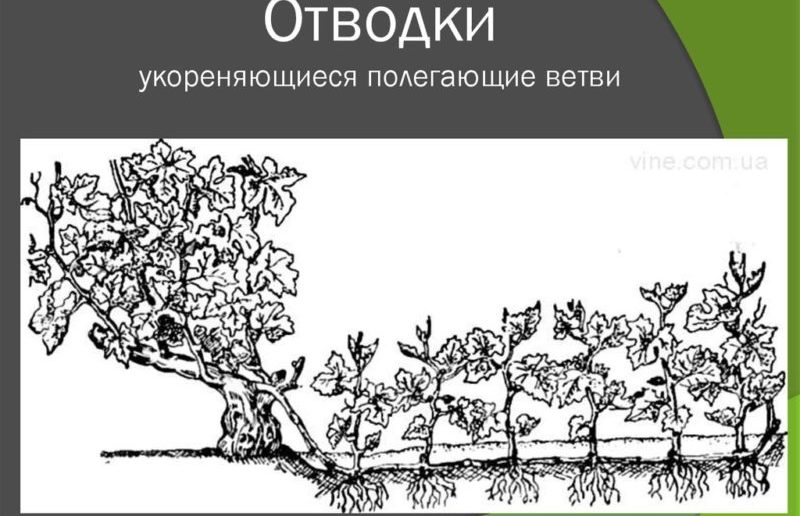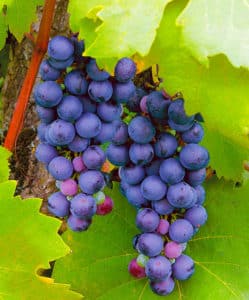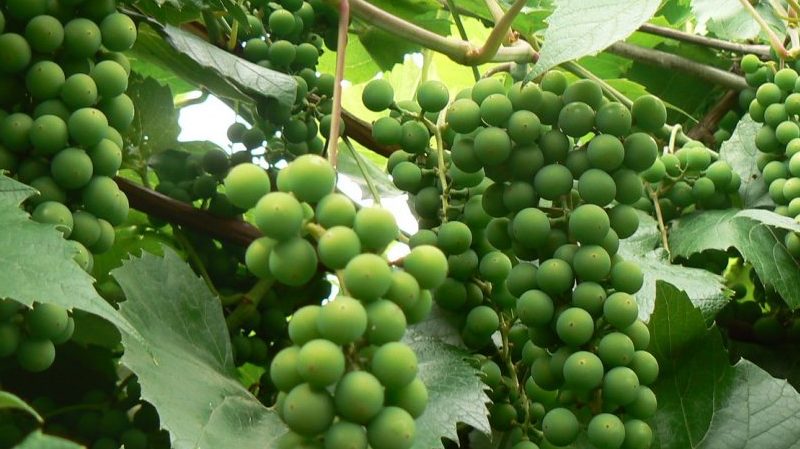Instructions for beginning winegrowers: how to propagate grapes by layering in the summer
Propagation of grapes by layering allows you to obtain new plants in a short time. The method ensures preservation of the characteristics and properties of the mother plant, good survival rates, and rapid entry into the fruiting period.
Layers are rooted grape vines that have formed next to the main bush. They receive nutrients and water from it and have their own root system. You will learn how to take a shoot and root it from the article.
Is it possible to propagate grapes by layering in summer?
Yes, you can. Layerings take root better in summer because they are saturated with warmth, sunlight and regularly supplied moisture.
Important! This method allows you to successfully propagate grape varieties that are difficult to take root, for example, Delight, Friendship, Baikonur.
Advantages and disadvantages

Advantages of the method:
- old bushes are restored and propagated by layering;
- receive planting material for further planting;
- increase the area of their own vineyard and make a profit from the sale of seedlings;
- preserve the varietal characteristics of the mother vine;
- They get a harvest already in the first year after planting.
In this case, the layering takes root by 95%. The only negative is that the young growth greatly depletes the mother plant.
Optimal timing for summer propagation of grapes
Experienced gardeners recommend propagating grapes in July, when the shoots stretch up to 2.5 m.
So, by autumn, the young bush will have formed a full-fledged root system, and it will be ready to be separated from the main vine.
Favorable days
According to the lunar calendar 2020 favorable days for working with grapes are considered 5-7, 10-12, 15-16, 24-25 August.
In June 2021 — 2-3, 6-8, 11-13, 16, 21-25, 29-30.
In July 2021 - 4-8, 13-15, 19-23, 26-28 and 31.
In August 2021 — 1-6, 10-12, 15, 17-19, 23-24, 30-31.
Suitable grape varieties
For this method of propagation, grape varieties are selected that are resistant to diseases, pests, frost, drought, and sudden changes in weather.
The higher the stability coefficient, the lower the value.
There are varieties:
- with 1 point - rarely affected by oidium, gray mold, mildew, have excellent survival rates;
- 2 - highly resistant and easily rooted varieties;
- 3 - average susceptibility rates;
- 4 - up to 50% are exposed to diseases;
- 5 - the weakest varieties.
For propagation of grapes by layering, varieties with 1 and 2 points are preferred. They are easily formed in the northern regions, in the Urals.
These include Kishmish, Flora, Bogotyanovsky, Agate Donskoy, Athos, Dubrovsky pink, Pleven, Pineapple, Purple early, Aleshenkin's gift, Krasen.
Selection and preparation of layering
Choose a healthy shoot without obvious signs of damage, 2 to 2.5 m long. It is good if it is powerful and grows from the base of the bush.
The escape is taken aside. Remove leaves from the part that you plan to dig in.
Reference. Preparation of shoots depends on the method of their rooting. The main thing is to choose a strong and high-yielding variety as a mother bush.
Ways to root them
Add parts of the grape bush in several ways. The type of layering affects the reproduction process.
Features of rooting horizontal shoots using the underground method:
- Select 1 lateral young vine at the base of the bush.
- Dig a trench 20 cm deep and 50-100 cm long. Fill it with a mixture prepared from equal parts of humus and fertile soil. Add 2 liters of wood ash and 20 g of superphosphate.
- The cuttings are placed in a trench so that the buds remain on the surface. Secure it with pins.
- After the appearance of young shoots 10 cm long, their bases are covered with moist soil, and the buried vine is completely covered with soil.
Rooting arcuate layers:
- The vine is placed in the soil and only its curved part is pressed to the ground.
- The parts are secured with pins.
- The top is brought to the surface and tied to a support.
In this case, a whole grape sleeve is used, from which up to 20 new seedlings are obtained in the fall.
Green cuttings are rooted according to the following scheme:
- In early May, during pruning, 2-3 grape shoots are left, which bend down easily.
- When the shoots reach a height of 1 m, they are cleared of leaves and tendrils.
- Dig small trenches 20 cm deep. Pour 1 bucket of water into them and place the shoots in an arc.
- Sprinkle with earth. The tops are lifted and tied to a support.
To root vertical layering, use the following instructions:
- During spring pruning, the shoots are cut so that they retain 2 eyes.
- Wait until shoots 20 cm long grow from the buds.
- Near their base, a hill is formed from nutritious soil: 1 part humus, 1 part fertile soil, 1 liter jar of wood ash, 10 g superphosphate.
- Hilling is repeated after the cuttings grow another 20 cm.
- Pinch off the tops, leaving 3 pairs of leaves on them.
The hilling method is suitable for propagating bushes in which, when planted, the “head” was placed 30 cm below the edges of the recess.
Features of rooting shoots using the catavlak method:
- Dig a long trench 50 cm wide and 20 cm deep.
- The bottom is well loosened, 1 part of humus and 1 part of fertile soil are added.
- The roots of the parent bush are exposed and cut off, leaving only the heel roots.
- Strong annual shoots are left on the vine. The eyes are removed in those places that will be buried.
- Place the bush in a ditch, bending one shoot into a loop. They pass it under the vine so that the end comes out next to it.
- The remaining shoots are brought to the surface of the soil, where a new plant will form. They are trimmed, leaving 2-3 buds on each.
- The trench is covered with soil, compacted and watered.
The katavlak method involves using the entire bush. At the same time, new plants will take away all the forces of the mother. The shoots take root by the end of summer.
Planting after rooting
The shoots fully ripen by mid-September. The cuttings are dug up and divided with pruning shears into several separate rooted seedlings.
They are planted in new places that are well warmed up by the sun's rays.
How to propagate grapes by layering in the summer:
- Prepare holes measuring 60 x 60 cm, 1 m deep. At the bottom, drainage is made from pebbles, pieces of brick or crushed stone with a layer of at least 10 cm.
- Mix 0.5 parts sand with 1 part crushed stone and 3 parts fertile soil. Add a 1 liter jar of wood ash. Fill the holes, thoroughly pouring each layer (25 cm) with water.
- Seedlings are placed. Planting depth is 45 cm. The top layer of soil is well compacted and watered.
The seedlings are cared for like a mature vineyard.Water 2 times a week, loosen the soil, remove weeds, inspect the bushes for emerging pests and signs of diseases.
Peculiarities of reproduction depending on the type of grape

Grapes can be dessert or technical. The first type is suitable for making wine products, and the second - for home use or sale. Grape propagation by layering is carried out for technical varieties.
Early ripening ones are propagated by the underground method, mid ripening ones - vertically, late ripening ones - horizontally. This will give the cuttings time to form a root system before the onset of frost.
Depending on the region
The method of dividing grapes by layering is suitable for the southern regions, where there is a long growing season and warm summers.
Residents of the northern regions are better off using other methods, for example, cuttings.
Further care
After planting, seedlings need regular and abundant watering. The first procedure is performed after 10-15 days, repeated every 2 weeks. 5-10 liters of warm, settled water are poured under the bush.
More tips:
- The plant is fed in mid-September with a mixture of 10 g of potassium sulfide and 20 g of superphosphate. Apply 2 g to each bush.
- Remove the eyes, leaving 2 buds. This sets the direction of growth. The tops are pinched.
- For the winter, seedlings are covered with straw, spruce branches, spunbond or slate. The procedure is carried out when all the leaves have fallen and after the first frost.
- The following year, the bushes are inspected for the presence of pests and diseases. Water, prune, feed.

Advice from experienced winegrowers
Reproduction by layering has its own subtleties.
We recommend that you familiarize yourself with the advice of experienced gardeners:
- This method is used to divide grapes in warm regions.In northern cities, summers are short, so new plants do not have time to take root.
- For planting seedlings, preference is given to well-lit areas protected from drafts.
- Use only fertile soil. Otherwise, the layering will not be fully saturated with nutrients.
- For propagation, take a vine 2-2.5 m long. Measure it with a centimeter or tape measure.
- The branches are carefully tied with twine, ropes, thin pieces of fabric so as not to damage the leaves and shoots.
- Provide proper care for plants.
- When transplanting rooted cuttings, they do not fuss or rush. There have been cases when shoots are damaged and a weak root system is formed.
Conclusion
Propagation of grapes by layering is a labor-intensive process that requires care and precision. As the mother bush, varieties that are not suitable for cuttings are chosen.
For beginners, it is better to choose the underground method for dividing shoots, as it is considered the simplest. After rooting, be sure to care for new bushes like adult plants.